Collector’s Guides • 07 Sep 2019
The Patek Philippe Complications
Within the Complications collection lie some of Patek’s most pragmatic and iconic timepieces: for instance, the Annual Calendar, which the company debuted as a world-first in 1996, as the Ref.5035; the worldtime watch, introduced in 1937 during the proliferation of railway networks; the chronograph wristwatch, introduced by Patek Philippe as a monopusher in 1924. You will find combinations of several of these complications offered within the same watch, for instance in the dazzlingly blue 5930G, a worldtime chronograph, and the 5905, a striking modern-classic amalgamation of the annual calendar and chronograph.

New for Baselworld 2019 is the Reference 5212A, a novel, charming, yet quintessentially Patek Philippe in the Calatrava aesthetic. This is a Weekly Calendar, with five hands emanating from the centre stem of the dial – telling the time, date of the month, day of the month, and the week of the year. Apart from the whimsical touch of knowing the week of the year without a smartphone or mental gymnastics, there are various regions in Asia and Northern Europe, most notably Germany, that reference the Kalendarwosche, or calendar week, and for whom this watch will be of particular utility. The calendar layout conforms to the ISO8610 standard, for which Monday, as the first day in the first full week – that which includes January 4th. The typeface on the dial, uncharacteristically non-homogeneous for the world’s greatest watch manufacture, is based on the handwriting of one of the watch’s designers.

The numerical reference, “5212”, is an anagram of the Reference 2512 from 1955, a 46mm-massive, three-hand yellow-gold wristwatch from which the 5212’s double-stepped lugs are inspired. As Wei Koh, editor-in-chief of Revolution Watch magazine, recently said in an interview with Mr. Thierry Stern, “Patek… is the master of lugs”, and it would be difficult to disagree. The lugs on the 5212 Weekly Calendar, as they are on, among others, the 5320 and now-now-discontinued 5970 (one of my all-time favourite watches) are angular yet shapely, the changes in profile well-delineated without being harsh; evoking some physiological sensuousness. Of additional appeal is that it is cased in stainless steel: a rare metal for Patek Philippe, and even more so in the Calatrava collection.

Annual Calendars
Another modern classic and a mainstay in Patek Philippe’s Complications domain is the Annual Calendar.
The Annual Calendar was conceived by Patek Philippe – or rather, by a bright engineering student at the University of Lausanne who joined the company – in 1996 as a more accessible, easier-to-set, more legible alternative to the brand’s perpetual calendars. Perpetual calendar mechanisms typically employ a long lever traversing the top of the movement, guided by a mechanical programme (essentially, a programme-wheel with various notches corresponding to 31-, 30-, 29-, and 28-day months), that transmits the mechanical information to other components and mechanisms. Where QP mechanisms account for the month of February, with its 28 days (or 29, in a leap year), QAs do not, and must therefore be reset once a year, at the end of February.
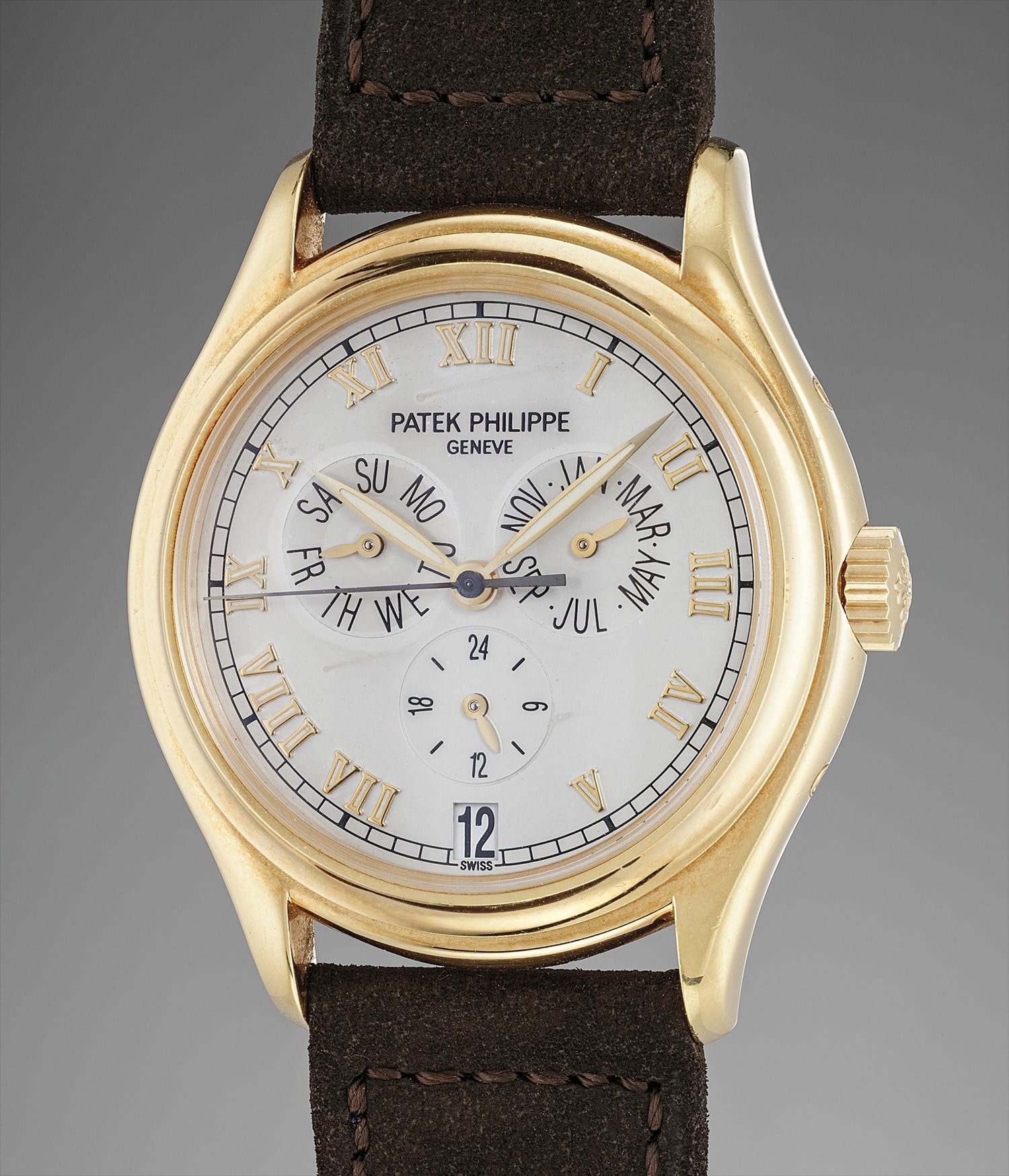
Quantiemè annuel mechanisms differ in that they eschew the more complex assembly of the perpetual calendar and its lever-cam interplay; however, QA movements typically involve an approximately twenty percent increase in part count, owing to the stacks of gear trains required. It is therefore debatable in the net analysis that QAs are less costly to produce than QPs; however, it is possible that the former may enjoy a larger market than the latter, owing to the aforementioned differences in user-friendliness, in addition to the markedly-lower relative point-of-entry.

Of the Annual Calendars, my undoubted favourite is the Ref.5235G, a watch whose styling is such a departure from the conventional PP aesthetic – a true thinking person’s choice, if one considers the finer points that this regulator annual calendar has to offer. It is not so difficult to miss them – the case, for instance. The steep, unapologetically straight lugs recall those of the Ref.3448 and 3450 perpetual calendars; the buckle, with the company’s name printed with Art Deco typography in relief.

Also unique is the vertically-brushed dial; bright silver on the outermost minutes track, grey in the centre; white on the concentric azurage guilloche in the subdials, all of which give the dial of the 5235G some play in appearance as it interacts with the light. New for 2019 is the 5235R in rose gold; the G has since been discontinued.
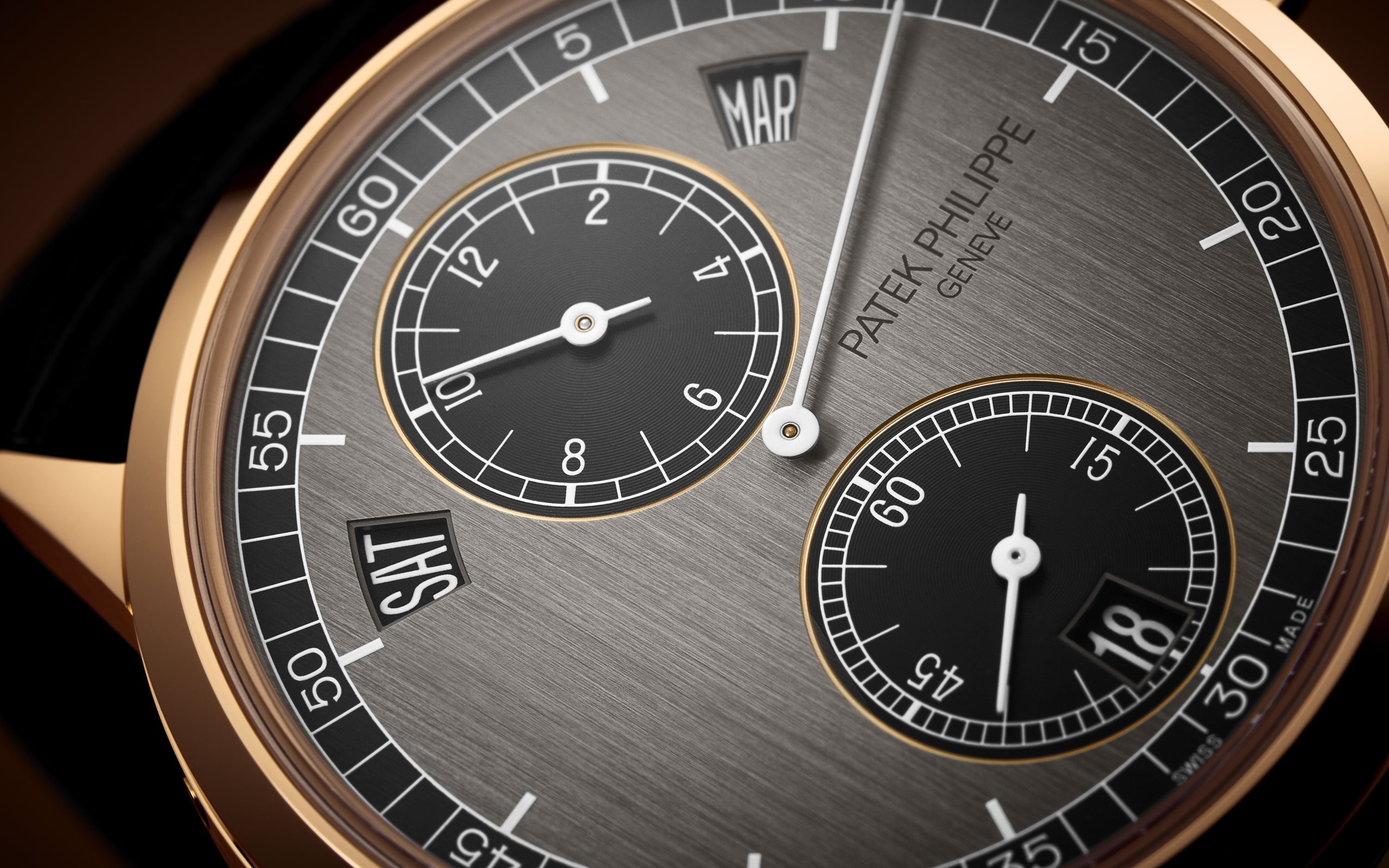
Where the 5235G was cool, sleek, unobtrusive, the 5235 executed in rose gold, is bold, striking, yet in keeping with the refinement expected from a Patek Philippe. Like the G that came before it, “Patek Philippe” is engraved on the dial, rather deeply, but left unlaquered, unique to the model.
Where the 5235 shines is in its movement: the 33mm Cal 31-260, unique to the 5235, not utilised even in derivative form in any other model. Where the commonplace Cal 240 has more rounded, softer contours around its bridges, those on the 31-260 employ sharply-defined edges; the bridges supporting the partially-exposed gear train from the barrel to the balance wheel contoured in unison to the curvature of the gear train, a pleasingly-lyrical arrangement. It is also considerably well-finished: apparent are the sharp external (i.e. obtuse) angles, as are the thick, convex bevels, smoothly polished, with well-delineated edges. The 5235 also houses the only serially-produced Patek Philippe movement to utilise both the silicon Pulsomax escapement and Spiromax hairspring.
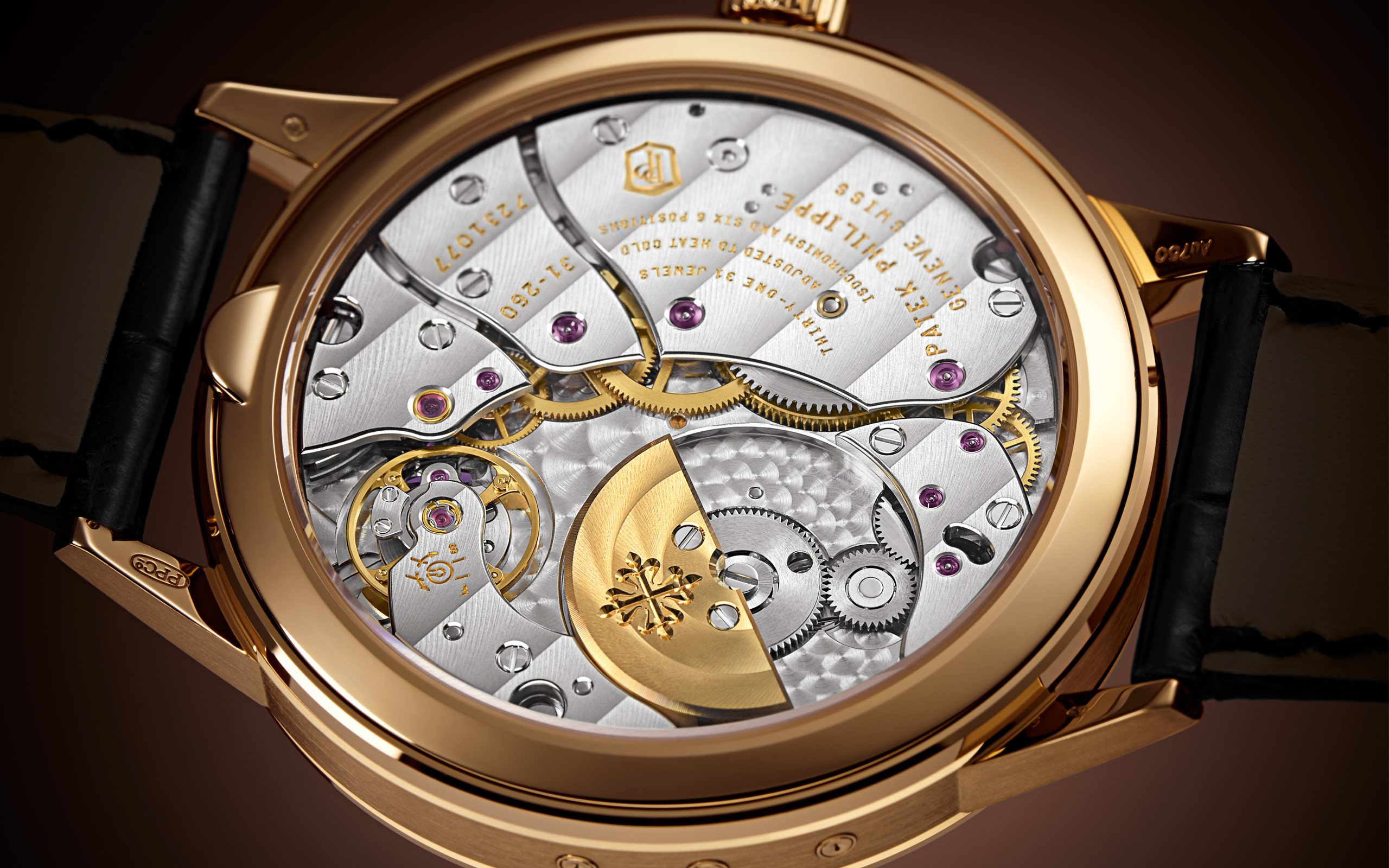
Should you prefer an Annual Calendar with the classical appearance as found on the original Refs.5035, or the 5056, with its moon-phase display in lieu of the former’s 24-hour subdial, the Ref.5146 is worthy of consideration; it is available in five case-dial colour permutations, in a more modern 39mm. I particularly fancy the 5146G-010 with its slate grey sunburst dial – a thoroughly contemporary profile with an underlay of restraint.
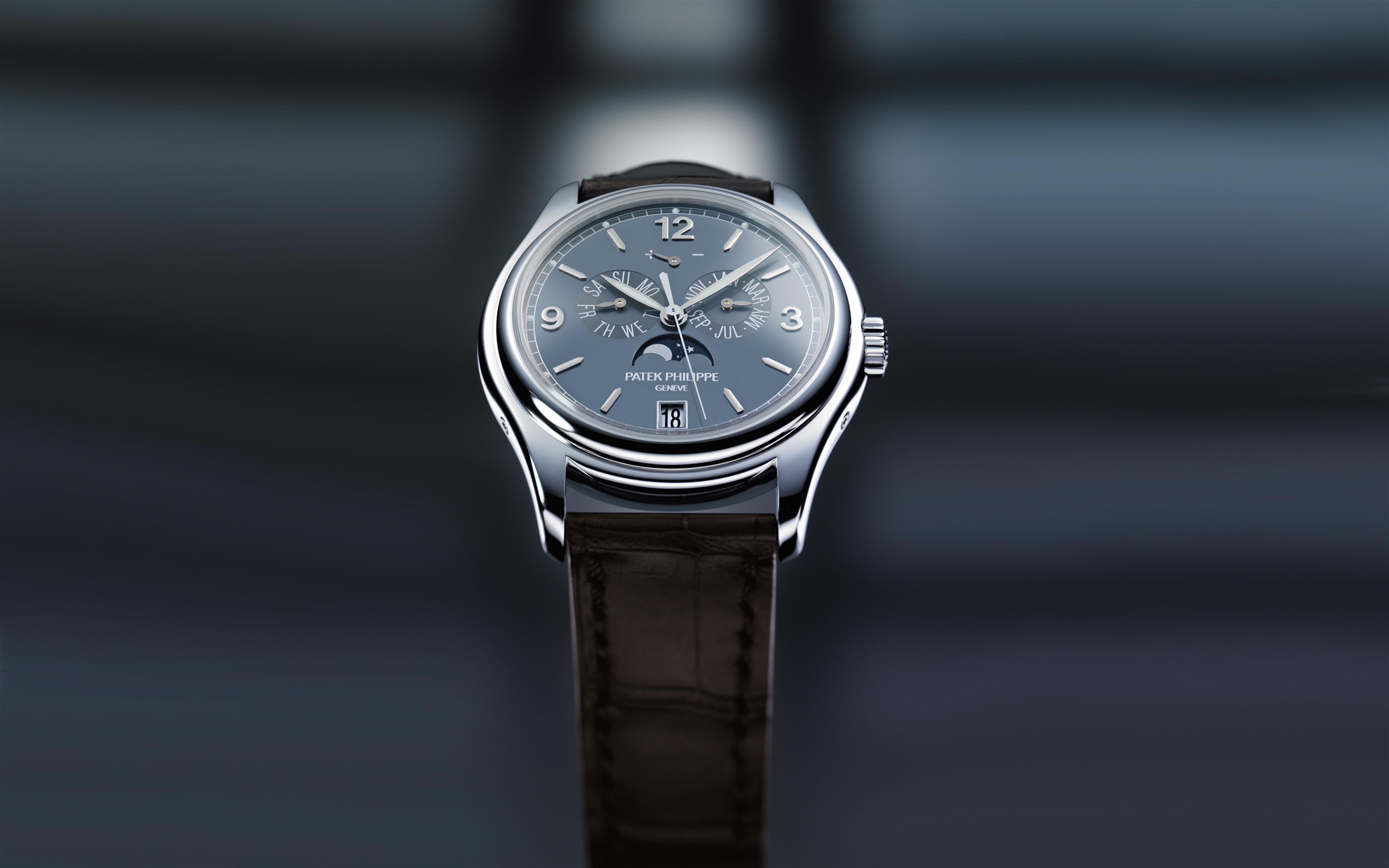
Alas, one of my fondest Patek annual calendars with a particular dial configuration has now been discontinued, the Ref.5396 with “Breguet” numerals and dauphine hands, introduced in rose and white gold at Baselworld 2016, with their respective mid-grey, sunray and grained silver dials. My pick would be the former. It is wonderful, the juxtaposition of the elegant, softly contoured numerals against the somewhat strident outline of the dauphine hands, framed with the circumference of spherical minute-markers. That is the confounding nature of Patek Philippe: one does not have ample warning before they discontinue a watch!

In keeping with the current popularity for blue dials, Patek Philippe introduced the 5205G-013, in the classical three-window 5205 layout, at Baselworld 2018. It is stunning; it is a piece I would like to personally own after the 5235G. To say it is outfitted with “a blue dial” is a description of the lowest order, for the midnight blue radiating from its centre, gradating to navy then black at its fringes, is possessively beautiful. It is a magnet of attention for one’s wrist; regal without being stuffy. I find the skeletonised lugs intriguing, in almost a technical way; reminiscent to the ducts on a fast automobile, or the intake of a supersonic turbojet engine, for instance. The 5205 bears more than a passing resemblance to the mag-daddy Grand Complication 5208 – similar three-window calendar display, pierced lugs – though the latter, if at all attainable to acquire, costs in excess of an order of magnitude more than the former.

Women who prefer more refined sizing and gem-set bezels are well-catered for with the Ref.4947 – an Annual Calendar with moonphase in 38mm. My personal preference for a special lady would be the 4947G-001 in white gold with a stunning, almost electric-blue sunburst dial; second in preference to only the extraordinarily beautiful “peacock” blue-grey 7130G-016 World Time within the Complications range.

But the ultimate Annual Calendars are those from the Advanced Research department – that the watchmaker has chosen this complication on which to execute its cutting-edge technical development does justice to its importance to its place in both the Patek Philippe line-up as well as in its preeminence among annual calendars. Four of them were made, as limited series, from 2005 through to 2008. The next Advanced Research enhancements were featured in a perpetual calendar, the 5550P. It was six years before the next Advanced Research model was reintroduced, but being 2017, and coinciding with the Aquanaut’s 20th year, Patek’s Skunk Works team elected to place their new developments into a limited-edition, avant-garde Aquanaut Travel Time.
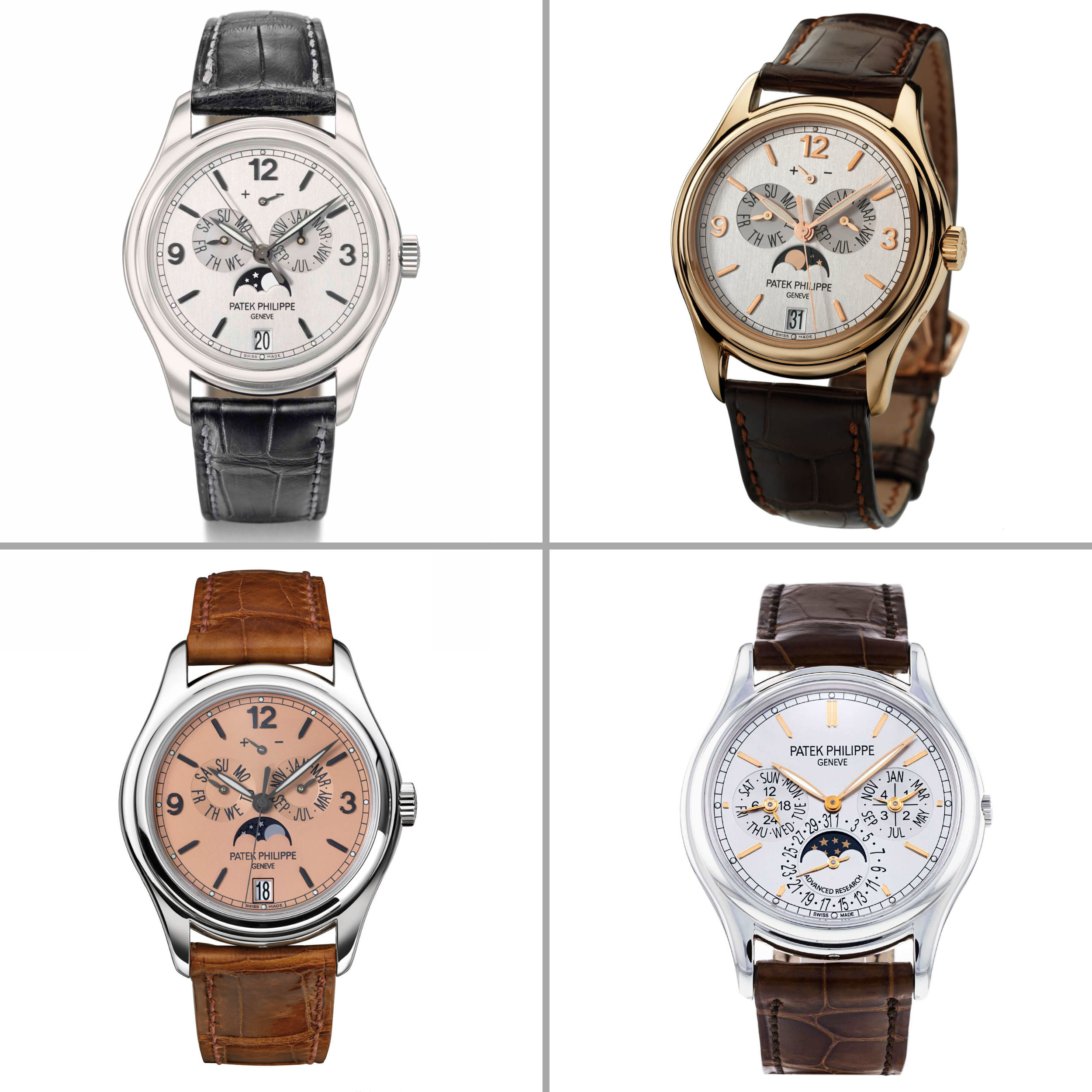
Annual Calendar Chronographs
Another eminently wearable and very handsome complication is the Annual Calendar Chronograph, which was conceived as the Ref.5960P, introduced in 2006. It was also the first in-house chronograph developed by Patek; featuring a flyback mechanism and a vertical clutch, the 456-part CH28 was nonetheless functional and robust. It is commendable that such a complicated piece is still scarcely thicker than many time-only watches of other makes, standing at approximately 13.5mm – such is the charm of Patek; maker of watches as visually appealing in a show cabinet as they are ergonomically pleasant at the end of an active day.
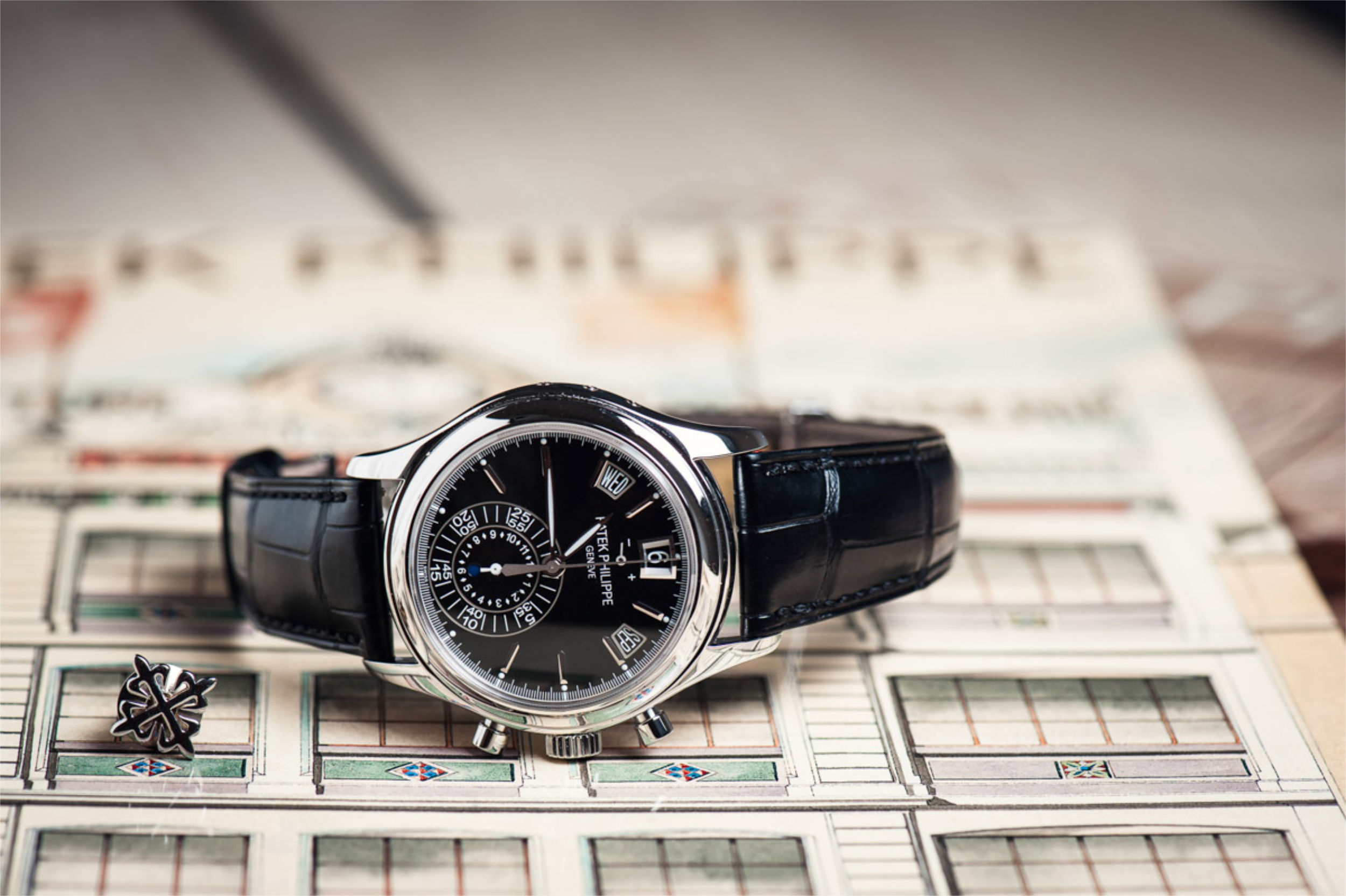
The stainless-steel Annual Calendar Chronograph is, alas, no longer available in stainless steel; the 5960/1A with a steel bracelet was introduced in 2014, only to be discontinued in early 2018 (it stands that with Patek, whether it is ringing up your local dealer for a special allocation, or deliberating on a purchase of an eye-catcher, it bears to do one’s research yet not waste time). In its place is the sporty, blue-dial 5960G, with pump-pushers and red highlights in a case size of 40.5 millimetres; the bolder 42-millimetre 5905, with its rectangular pushers, is another more formal option.

I prefer the case of the 5905 over that of the 5960; the scalloped sides of the former is a sophisticated touch. Another difference between the two is that the 5960 has only a 60-minute chronograph, and the 5905, a 12-hour counter. But as chronographs are typically used to time short, dynamic durations, the comparative utility is somewhat negligible.

Chronographs
I am inclined to think of the chronograph (alongside the Travel Time watches) as the most pragmatic, utilitarian, humbly functional – permit me to justify myself – of the complications. Rooted in military, medical, and sporting utility, the chronograph has witnessed, and indeed, been a most necessary party in say, the liberation of Allied POWs (portrayed in The Great Escape), in the measurement of a patient’s heart rate (via a pulsations scale), and in timing automotive races (via a tachymeter; a logarithmically-adjusted scale in miles or kilometres per hour).

In describing it as “modestly pragmatic”, I acknowledge the chronograph’s function in a spectrum of scenarios where the complication is not worn for complication’s sake, but as a tool: not unlike a mobile application one has on an iPhone. It enabled its wearer to perform a job, or otherwise, persist in existence: a telemeter scale, for instance, enables its user to measure the displacement between a visible and an audible event. Say, heaven forbid, one is in battle and sees the flash of artillery; one would then start the chronograph, and upon hearing the report, would stop the chronograph. The telemeter would then display the displacement to the target (or, more realistically, location of lightning); it is normally calibrated to a mean aggregate value, given that the speed of sound is a function of ambient air temperature.
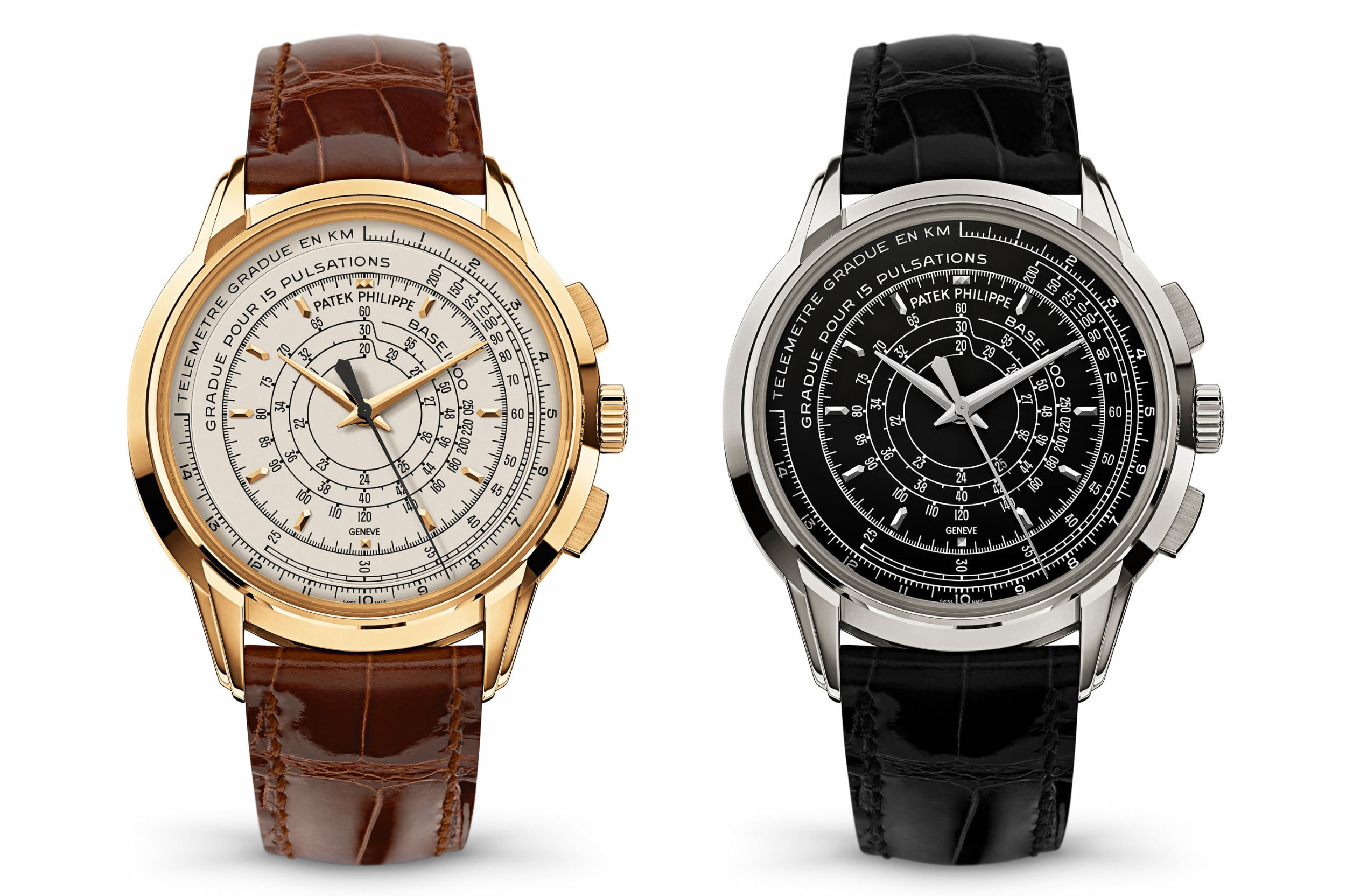
A high-end chronograph is remarkably difficult to construct: certainly more so than a perpetual calendar, for instance; there is limited user engagement (via the setting push-pins) with the latter, but tactility, linearity, is everything with the former. Aside from the minute repeater and rattrapante, a chronograph is the culmination, a demonstration of a watchmaker’s prowess. And so, it can only be expected that Patek manufactures among the very best chronographs in the land, but also beyond its borders.

The Ref.5070 is one of my choice references from Patek Philippe of the past decade or two – it is singularly large, at 42mm, but also characterful, beautiful. It was the company’s first simple chronograph in close to forty years, its design a tribute to a highly rare, oversized split-seconds aviator’s chronograph made by Patek in the 1950’s, the reference 2512.
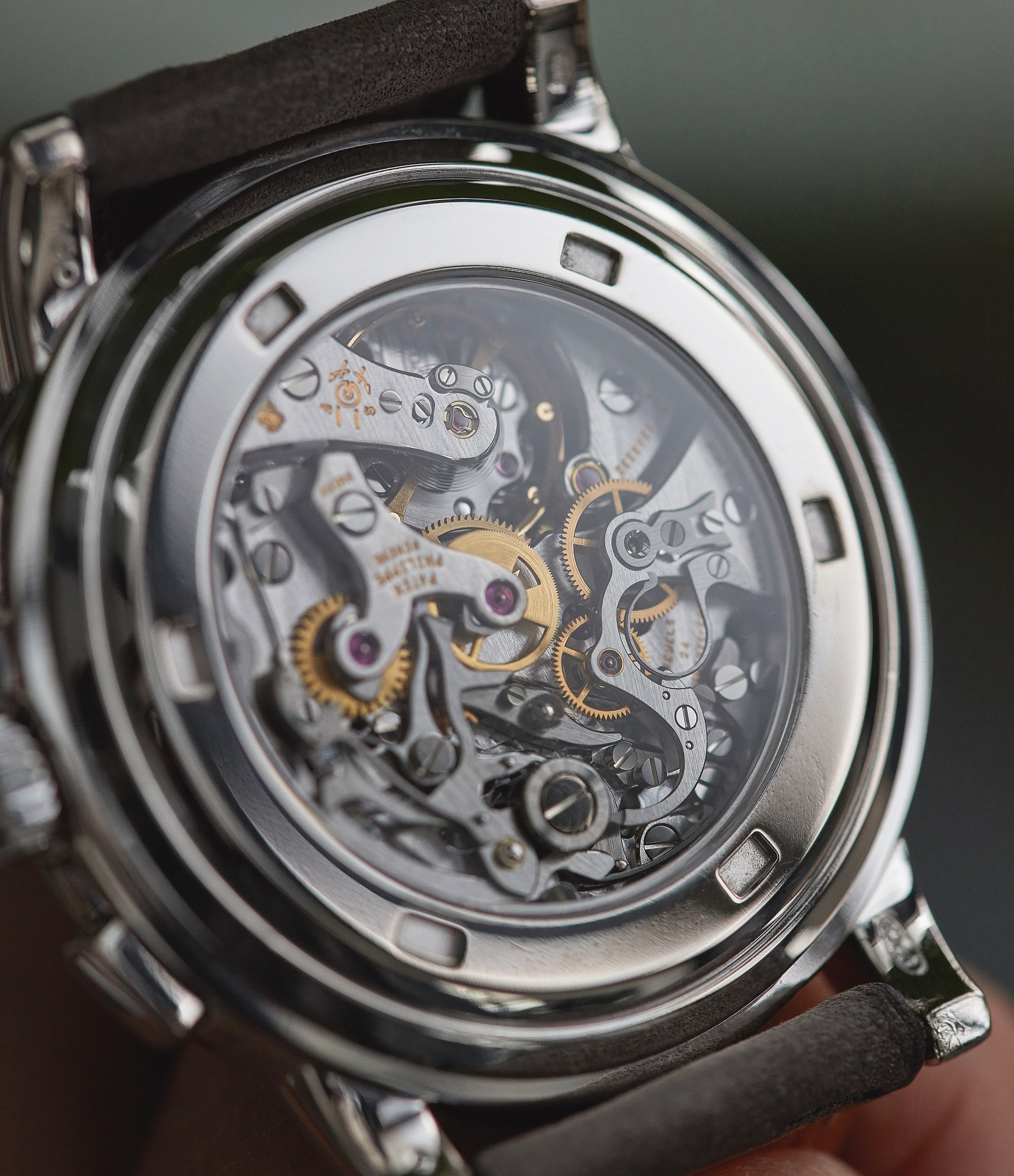
The 5070 was the last simple chronograph to use a largely-outsourced movement, the exceptionally-high-quality Nouvelle Lemania 27-70, which was extensively reworked by Patek to meet their standards. The movement in question is very attentively finished, not bereft of internal angles, and though slightly smaller than would be commensurate to the case size of the 5070, is a qualm easily overwhelmed by the cumulative appeal of the watch.

My preference of the 5070’s would be the final-execution “P” in platinum, finished with a stunning blue dial. There were some exceedingly rare variants produced in platinum with a salmon-pink dial for the London Exhibition in 2015, but for most, even the serially-produced 5070P is unobtainable: manufactured for less than a year from 2008, it really is a blue-chip watch, and owners are loath to release theirs to the market.
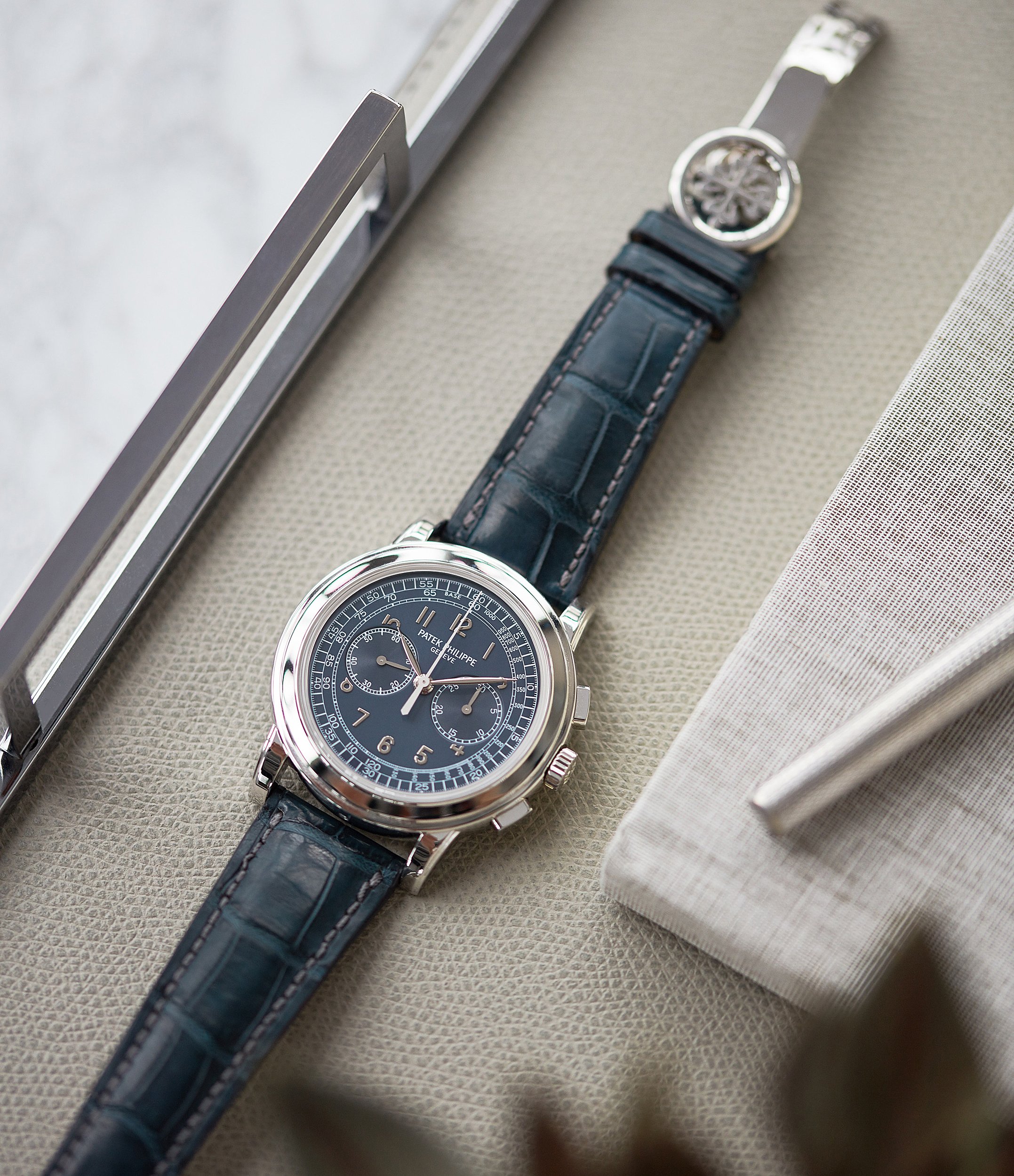
The 5070 was replaced in 2010 by the Ref.5170, containing an all-new in-house, manually-wound, horizontal clutch chronograph movement. I have personally handled the watch and confirm that the smoothness of the chronograph engagement is among the top five I have experienced (and PP occupies a significant proportion of the five). The CH 29-535 movement within may be classical in appearance and form, but it is thoroughly modern; optimisation in such areas as the gear teeth profiles, lever geometries, and the usage of a column-wheel cap translate fascinated observation into satisfying operation.

The CH 29-535 was not introduced in a men’s watch but debuted in the befittingly-titled Ladies First Chronograph at Baselworld 2009. The product of five years of development, the movement heralded a new era of autonomy for Patek Philippe: vertical, or in-house production enabled it to circumvent Swatch Group’s (which owns Nouvelle Lémania, the movement manufacturer) new policies restricting the supply of ébauches to external brands. Beating at 4Hz, finished to the highest standards and robust enough to form a base movement for the addition of further complications, the CH 29-535 features six novel technical patents, a testament to Patek’s commitment to optimising the reliability, robustness, and refinement of their movements.

The first three patents related to the reduction of chronograph backlash: backlash is what occurs when the chronograph hand stutters, or jerks (by definition, a non-linear movement) during activation. Patek ameliorated backlash by implementing an optimisation of tooth profile, enabling smoother meshing; it also utilised the column wheel cap, working in conjunction with the clutch lever, to improve depth of penetration between the clutch and the chronograph wheel. Lastly, Patek bypassed the use of the column wheel as a synchronising intermediary between the braking mechanism and the driving mechanism, by fitting the clutch lever with a finger piece that directly interacts with the blocking lever.
The latter three pertained to improvement of the reset mechanism: a slotted minute-counter cam; self-setting return-to-zero hammers, and bilaterally-jewelled bearings for both the minute and seconds hammers, on the same axis. These culminate in a highly refined, almost unbelievably lightweight reset experience.
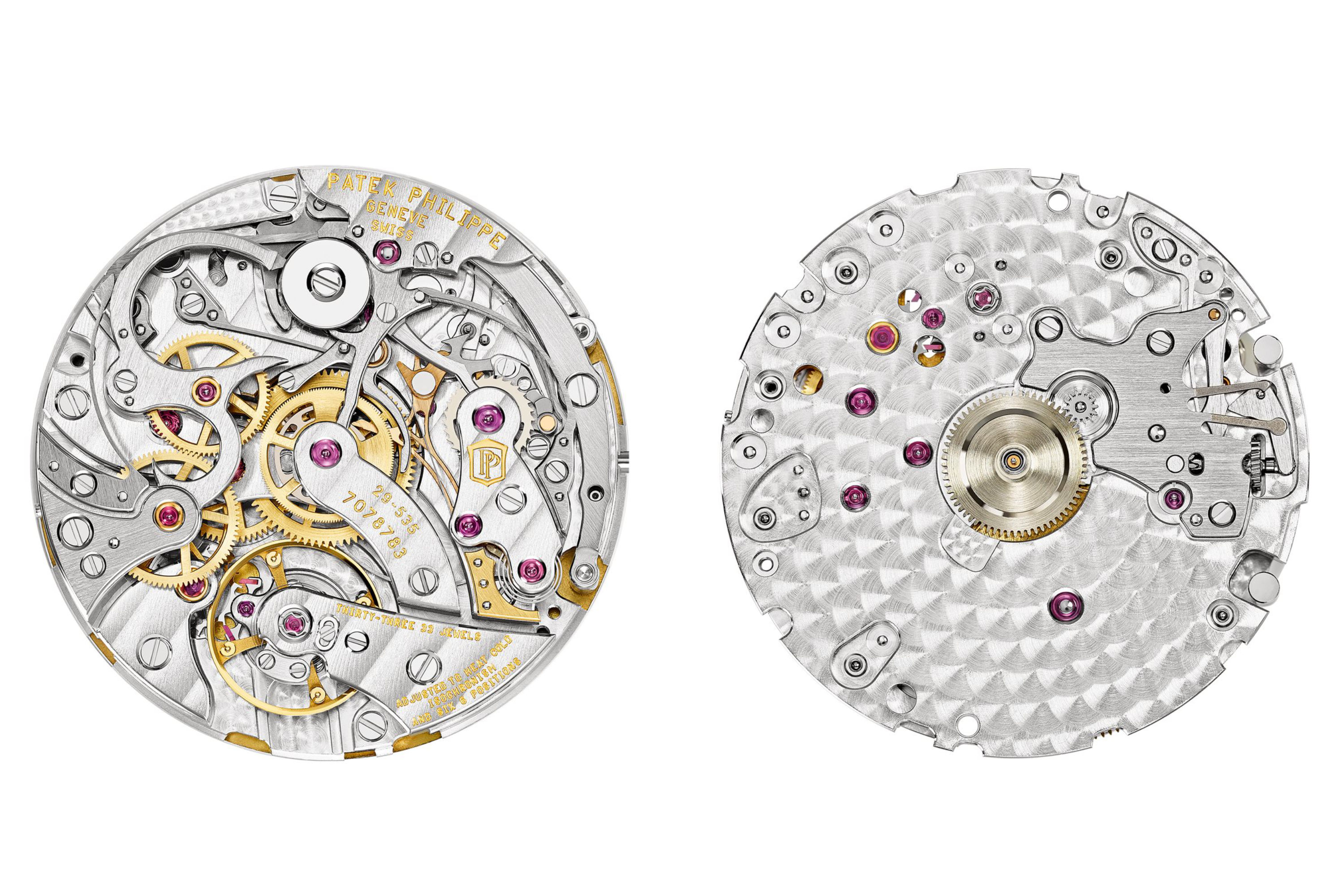
The 5170 was introduced first in 2010 in yellow gold, then in 2013 in white gold, rose gold in 2016, and finally, in 2017, in platinum, with, as the 5070P that came before it almost a decade ago, a stunningly blue dial, this time with baguette-cut diamonds for markers. The effect is bold, impressive, but never brash. It is my favourite of the 5170s, and was manufactured for close to two years until its discontinuation in 2019.
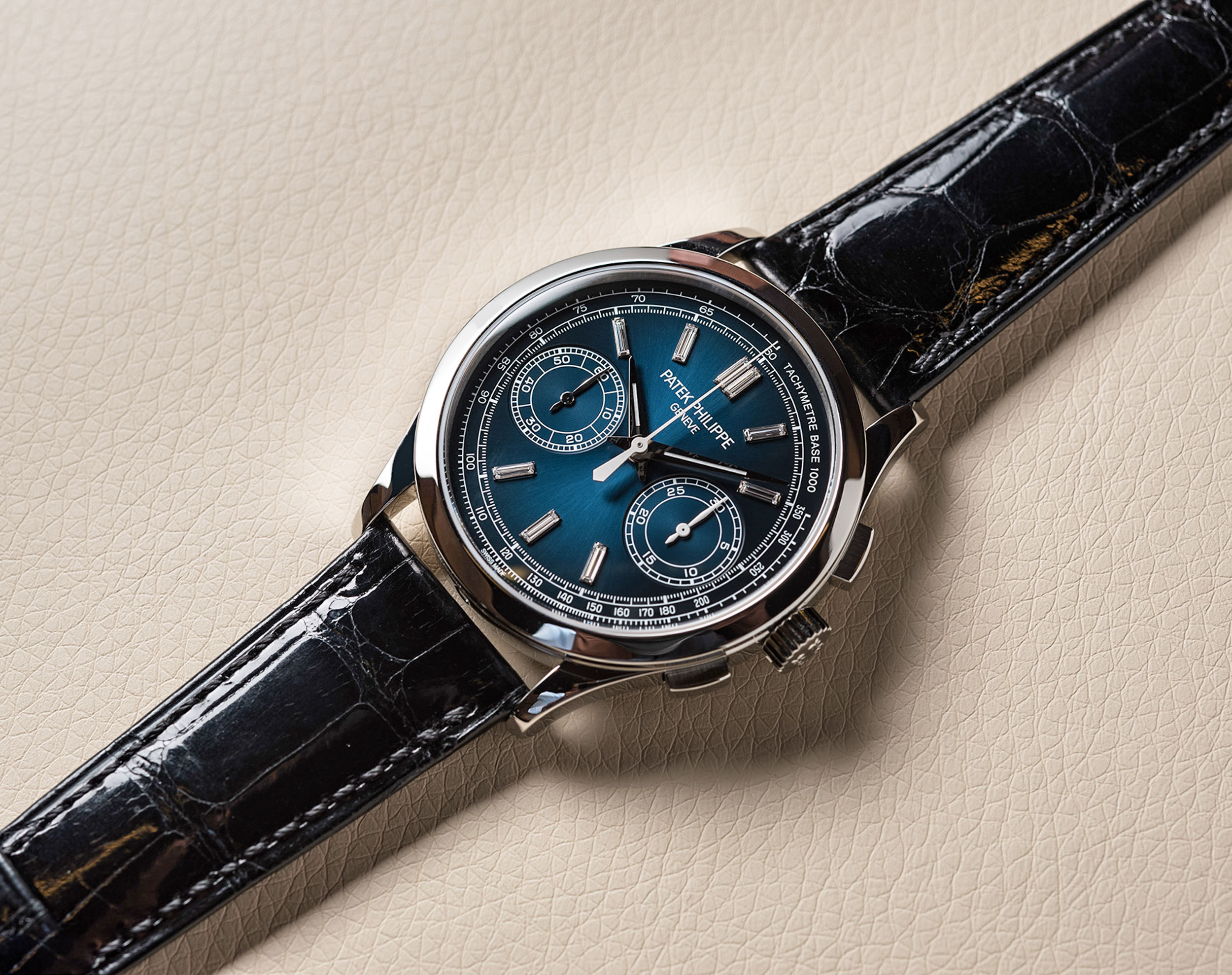
New for 2019 is the Ref.5172G, a fabulous coalescence of present-day and the past – borrowing its case profile from its sibling, the 5320, with its Art Deco three-tier stepped, or fluted lugs; its syringe hands, inspired by the Ref.1591, a unique stainless-steel perpetual calendar from the 40’s. In keeping with the vintage hark-back, the 5172 features a “box-type” sapphire crystal, that is, one with vertical sides that significantly protrude past the edge of the bezel, akin to the plexiglass crystals of the past.

Upholding the contemporary equilibrium is the petrol-blue, slightly grained, matte dial and matching calfskin strap, with stitching paired to the shade of luminous material used in the Arabic markers and hands. An intriguing touch are the radially-guillochéd, “onion top” pump pushers, which to me recall the turbines on a jet engine, and are a detail derived from the water-resistant, 35-millimetre Ref.1463 of the mid-20th century, also laconically known to Italian collectors as the “Tasti Tondi”, or simply, “round buttons”.

Collectors with a more feminine bent will appreciate that Patek Philippe, as it has in the past – with the exquisite ladies’ split-seconds chronograph, Ref. 7059 – offers an uncompromisingly technical, yet also disarmingly beautiful Ref.7150 chronograph, measuring 38 millimetres and executed in rose gold. This – in my view – rather concupiscent watch features Breguet-style numerals and hands, a box-type sapphire crystal flanked by a bezel housing 72 diamonds, and large, slightly sunken bicompax chronograph counters, flanked by a pulsimeter. Its pushers, like its male equivalent in the 5172, are also radially-guillochéd.

How beguiling is this – that this sub-ten-millimetre-high microcosm of yin-yang harmony, mechanically accomplished, aesthetically ravishing entity of watchmaking brilliance can actually be worn on the wrist, and owing to its litheness, doesn’t demand to be shed after a full day of wear? And to have a pulsations scale, well, the 7150 is hardly an optional implement for the female medical practitioner. She would likely also find the profile of the lugs physiologically germane; somewhat reminiscent of the idealised female calf. A diamond-set prong buckle and mink-hued alligator strap frame, and fasten, this quite perfect watch.
Pilot’s Watches
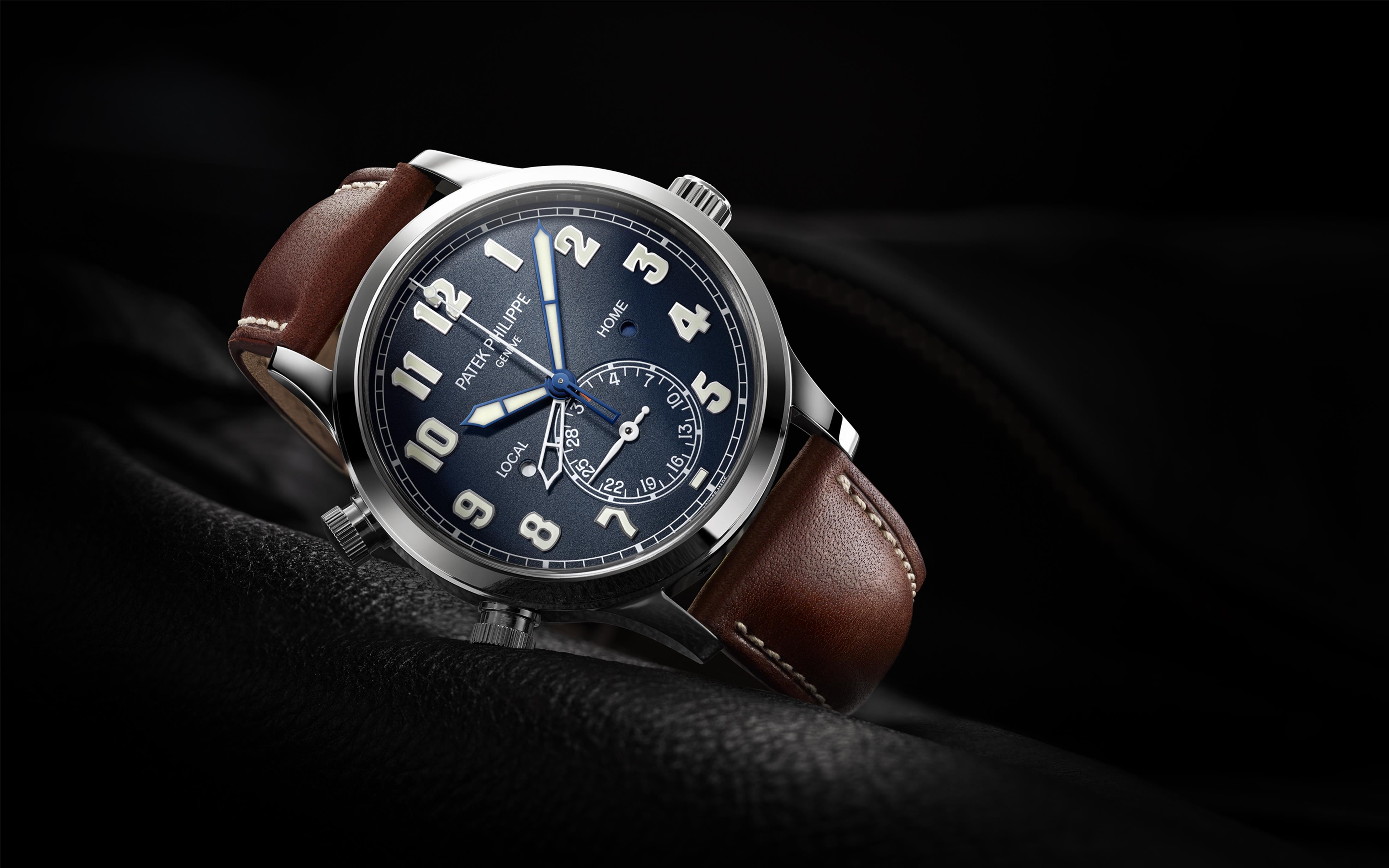
Contrary to the braying detractors’ views on the 5524G introduced in 2015, Patek has had considerable previous experience manufacturing not merely aviation-themed watches, but watches designed for aviators. One of which, a 55-millimetre hour-angle, split-seconds prototypal wristwatch dating to 1936, was sold by Christie’s in 2009 and attained a result in excess of 1.8mil CHF. The other is a time-only, hour-angle (or siderometer) watch. Both are on display at the Patek Philippe Museum in Geneva. Hour-angle watches, in conjunction with a sextant (to measure solar noon in his given location) and radio signal (to ensure perfect synchronisation with Greenwich Mean Time), facilitated more efficient navigational positioning.
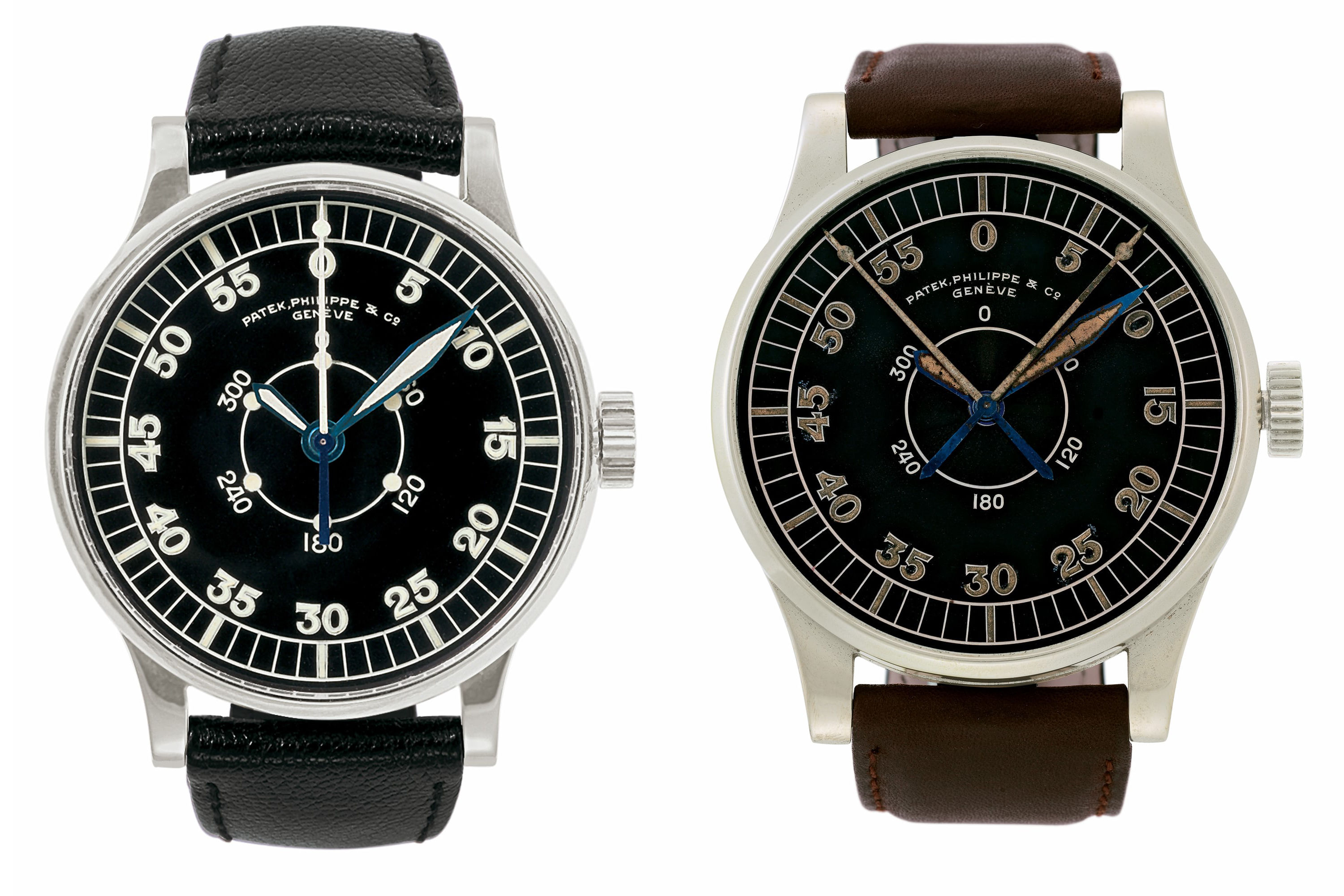
Despite the somewhat ambivalent journalistic response to the 5524G, it nonetheless became a hot, waiting-list watch, similar to that of its stainless-steel brethren the Nautilus, even today, and one would be clutching at straws to expect to see a Pilot’s Watch sitting in a display-case. Joining the 5524G in 2018 were the 5524R, in a similar size of 42mm, and a 7234R, in a more “mid-sized” case of 37.5mm.
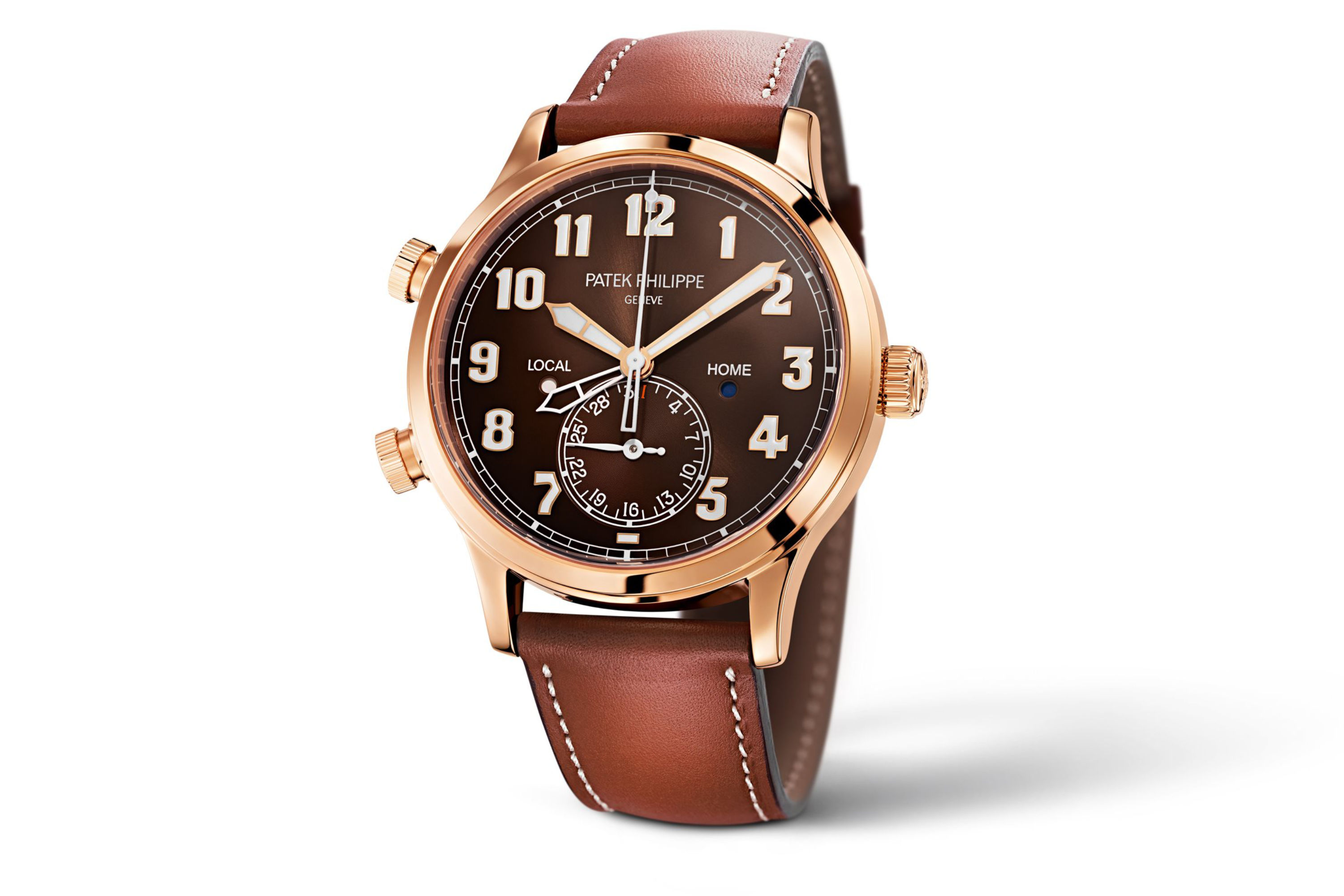
Unlike the 5524G, with its grained, matte blue dial, the 2018 additions feature copper-brown, sunray dials, gradated from a warm brown in the centre to black in the periphery. All three of them share the same brown calfskin strap and clevis-style buckle, a rather germane feature in keeping with the aviator theme, as well as the tried-and-tested Cal. 324 SC FUS, known most well in the ref. 5164 Aquanaut Travel Time.

Unlike the pushers on the 5164 Aquanaut, however, the Pilot’s Watch has lockable fluted pushers; they are released with a quarter-turn anticlockwise and locked with a quarter-turn clockwise. Of note is that the larger of the two, the 5524R, uses 5N rose gold, with higher copper content, giving it a marginally warmer, redder hue than its smaller counterpart, which uses 4N rose gold.
If you are looking for a very-high-quality, sub-ten-millimetre-thick travel watch which will be just at home at a board meeting as it would be in athleisure, lounging in first class – look no further. If you have a companion with whom to share your journey, the Patek Philippe Calatrava Pilot Travel Time is the ultimate power couple’s timepiece.
World Time
The lineage of Patek Philippe worldtimers may be traced to the rectangular-cased Ref.515HU for “heure universalle” – world time, conceived by a Monsieur Louis Cottier at the behest of Patek Philippe in 1937. Cottier was born in 1894 to an accomplished maker of watches and automata in Carouge, Geneva, Emmanuel Cottier. Cottier senior had in 1885 presented a World Time conception to the Societe des Arts, which, though unsuccessful, served as inspiration for the complication which his son executed to great renown in 1931.

Emergent during the last vestiges of the Industrial Revolution and accompanying the expansion of railway networks, the worldtime complication pre-dates the jet age of the fifties: during which tool-watches such as the Rolex GMT-Master, commissioned by Pan Am, were widely adopted. And unlike GMT watches, which serve only one or two additional timezones, with a true worldtime one is able to directly read the day/night time in the other featured (usually twenty-three) cities by virtue of a demarcated light/dark inner chapter ring that revolves once in 24 hours.

Cottier’s patented solution was to feature the local time, displayed by centrally-mounted hour and minute hands, mechanically coupled to an inner AM/PM rotating ring, read with respect to an external bezel on which the names of the twenty-four cities are inscribed. In 1954 the Ref.2523HU was introduced: the first Patek World Time watch with two crowns, credit to Cottier, the second of which enabled the city disk to be integrated as an extension of the dial, under the crystal. The inherent robustness of this solution enabled the city names to be printed, rather than etched, which improved legibility. All Patek Philippe worldtime watches henceforth have an integrated city-disk, and from the Ref.5110, are manipulated by a pusher at 10 o’clock.
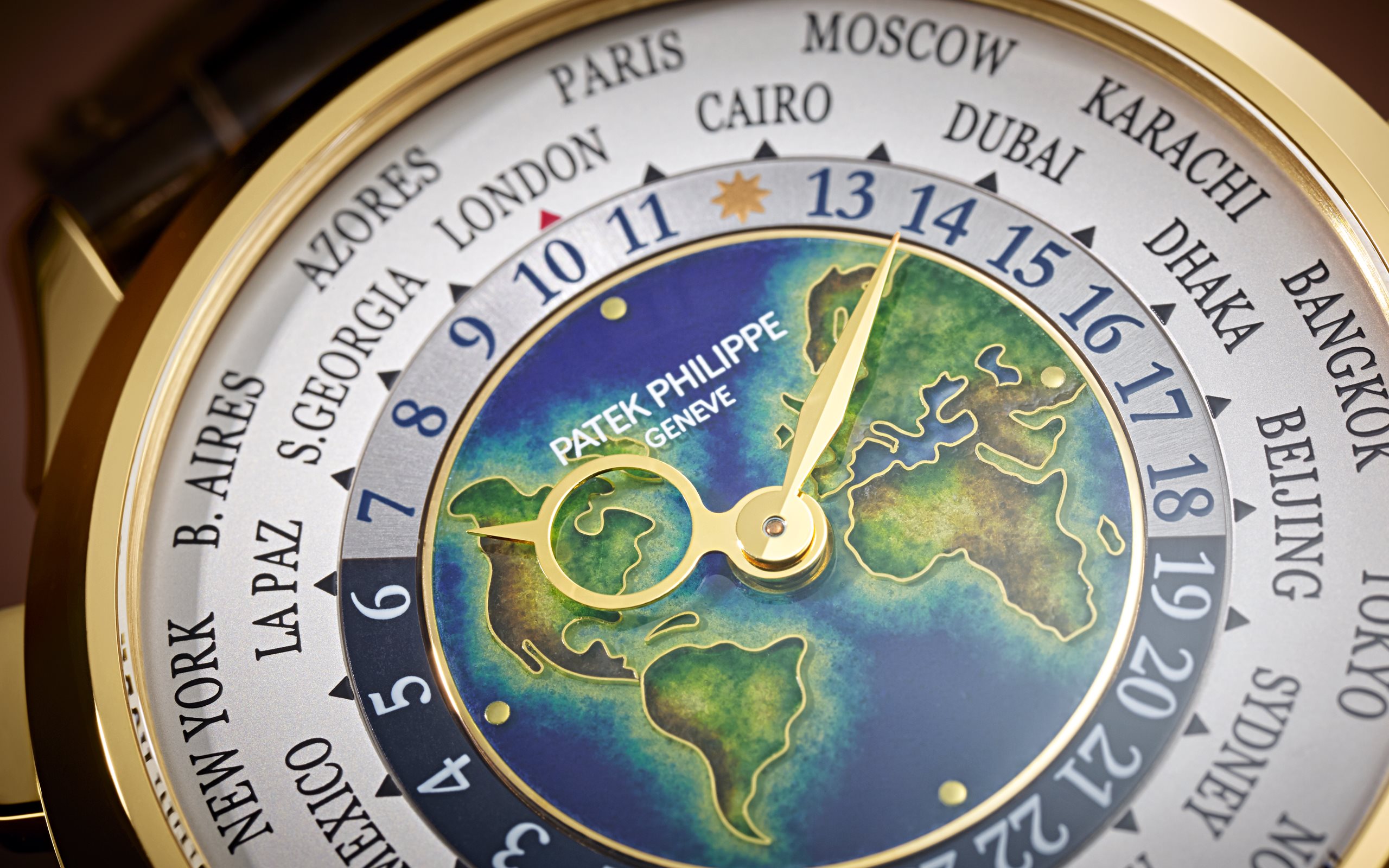
New for 2019 is the feverishly-coveted Ref.5231J Rare Handcrafts, the most recent iteration of the enamel worldtimes, offered alongside the 5131P, the last of the 5131 series. The cloisonné enamel planisphere represents Europe, Africa, and the Americas – and in the words of a seasoned Patek collector, “The finesse of the enamel work on the 5231 surpasses even that of the best of the 5131 series, namely the G and P versions.” The 5131 enamel worldtime series was offered from 2008 to much positive reception, after a period of close to four decades; the last had been the 2523.
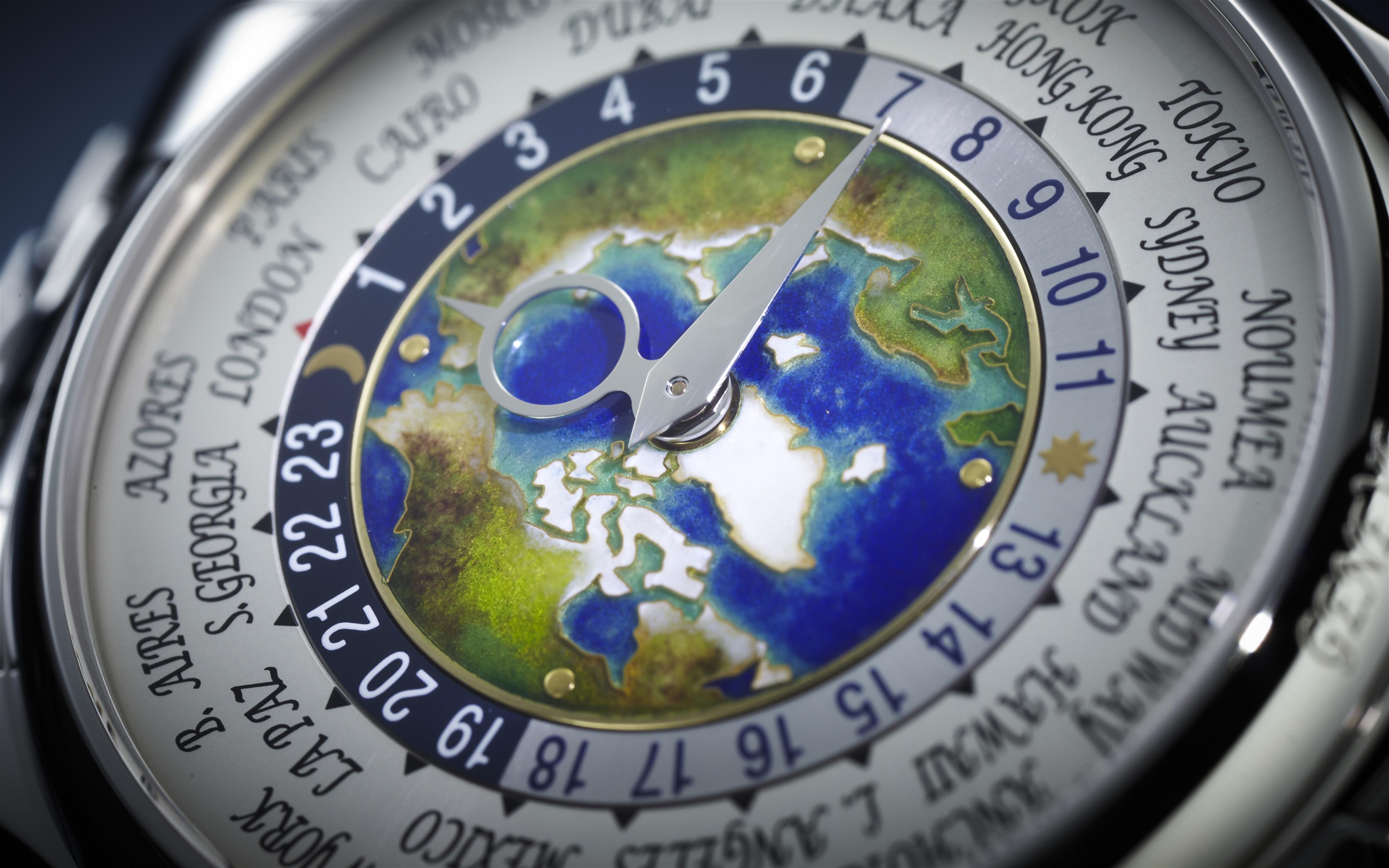
The Ref.5131J of 2008, shown below, is such an exemplar: it is simply gorgeous, on and off the wrist. The yellow gold “J” is the first modern execution of a Patek worldtime with enamel medallion, and while many argue that the quality of the cloisonné enamelling is superior in the later white gold ‘G’, rose gold ‘R’, and platinum ‘P’ versions, the author is partial to it for its warm hues. In the later three executions, the fringes of the continents cast a lighter halo into the blue of the sea, a gentle visual delineation from the shallow coastal waters and not seen on the ‘J’ nor in the early enamelled worldtime watches.

Of the regular, recent world timer watches, the 5130P, now discontinued, is the author’s favourite: the ice-blue guilloché sunburst dial in heavy relief coupled with the aiguilles ciseaux‘ scissor’ hour hand and reassuring heft makes its own case (unintentional pun). The current iterations of the standard worldtime, the 5230 in white or rose gold, are equally compelling: with its superbly balanced 38,5mm case and modern slate-grey centre medallion – guillochéd by hand on a rose engine – it is of its time, yet evocative of the mystery of travel associated with the mid-century advent of the jet age. Its hour hand is reminiscent of the Southern Cross constellation. Ad astra.

Should one desire an even more dynamic package in what must be the ultimate traveller’s timepiece, look no further than in the 5930G – which combines a worldtime complication with a self-winding flyback chronograph in a very contemporary iteration of the only other chronograph-worldtime that Patek has made, the specially-commissioned Ref.1415HU of the year 1940.
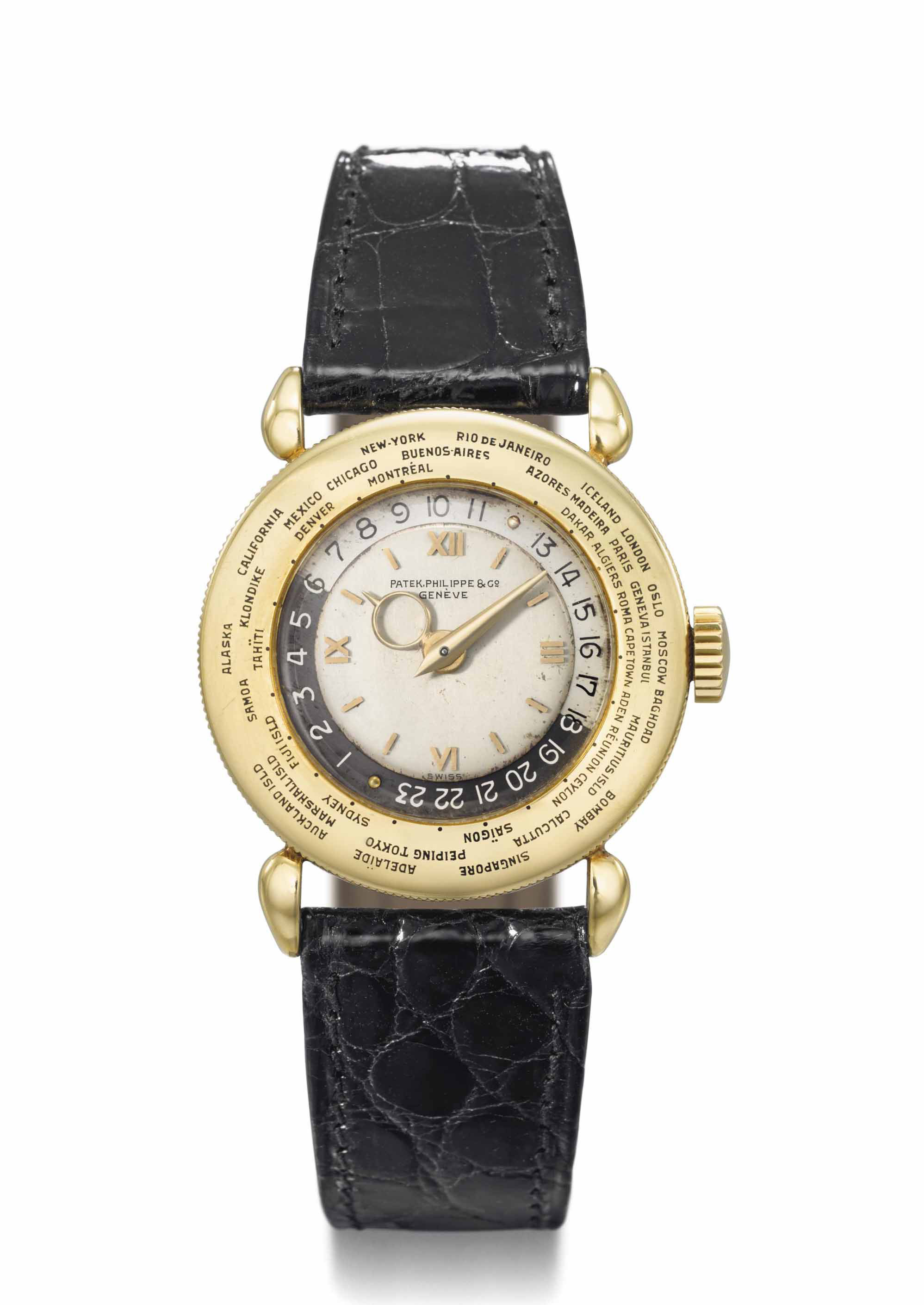
Women who find the 38.5 or 39.5mm cases of the 5230, 5131, and 5930 too obtrusive may turn their attention to the captivating Ref.7130 in rose or white gold: the latter in peacock-blue, and gorgeous on a lady. The 7130G-016 would be my instinctive first preference were I to purchase a Patek Philippe for a woman.

What does the future hold for the lineage of Patek Philippe’s most iconic complication? A natural evolution would be to have the 5230 in yellow gold and platinum. As to the rare, enamelled pieces, it remains to be seen if Patek will explore other techniques in the future, once the run of the 5231 in all the metals has concluded – champlevé enamel or miniature-painting, possibly – the former presents an inherent difficulty, given that it is a ‘reductive’ process, where metal is carved away and the resultant cells filled with enamel – rather tricky to execute on a small medallion. There is the question of diplomacy as well; given the marque’s commitment to the Chinese market and the likelihood of future Grand Exhibitions in the region, it is not inconceivable that the nomenclature for the present GMT+8 timezone has been replaced with that of Shanghai in current references. Given the firm’s motto, a comparison of world times across the decades will be an interesting study in the vicissitudes of the ebb and tide of global geopolitics.
[Editors Note: In the lead-up to the 2019 Patek Philippe Watch Art Grand Exhibition David wrote a series of articles covering the gamut of watches Patek Philippe makes, including: Part 1 The Calatrava, Part 2 Patek Philippe Rare Handcrafts, Part 3 The Patek Philippe Nautilus, Part 4 The Patek Philippe Aquanaut, Part 5 The Patek Philippe Complications and Part 6 The Patek Philippe Grand Complications]

Patek Philippe Watch Art Grand Exhibition in Singapore

Running from the 28th of September until the 13th of October Patek Philippe will be hosting the Watch Art Grand Exhibition at the Sands Theatre (Marina Bay Sands). Taking place during the Singapore Bicentennial year, the Grand Exhibition underlines the importance of Singapore and Southeast Asia for Patek Philippe. These markets are not only significant when it comes to the numbers of collectors and enthusiasts based in the region, they also play a major role in building an appreciation for the work of fine mechanical watchmaking. For more information click here.











